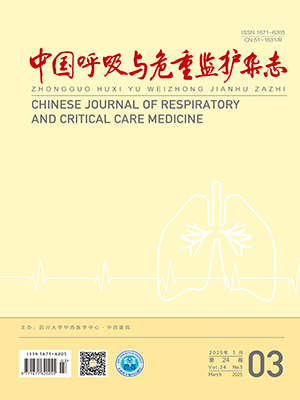Objective To compare the effects of high and low positive end-expiratory pressure( PEEP) levels on mortality and risk of barotrauma in patients with acute respiratory distress syndrome ( ARDS) . Methods Randomized controlled trials ( RCTs) were recruited from PubMed( 1966-2008. 9) ,EMBASE( 1980-2008. 9) , Cochrane Database ( Issue 2, 2008) , Chinese Cochrane Centre Database and CBMdisc ( 1978-2008. 9) . Related published and unpublished data and attached references were hand searched. All RCTs about ventilation with PEEP for patients with ARDS were included, then a systematic review were performed. Results Five eligible trials were enrolled in the systematic review. According to ventilation strategy, all trials were divided into subgroup A( low tidal volumes + high PEEP vs traditional tidal volumes + low PEEP) and subgroup B( low tidal volumes + high PEEP vs low tidal volumes + low PEEP) . In subgroup A, high PEEP was associated with a lower mortality[ RR 0. 59, 95%CI( 0. 43, 0. 82) ] and a lower prevalence of barotraumas [ RR 0. 24, 95% CI( 0. 09, 0. 70) ] in patients with ARDS. In subgroup B, the difference in mortality[ RR 0. 97, 95%CI( 0. 83, 1. 13) ] and barotraumas[ RR 1. 13, 95% CI( 0. 78, 1. 63) ]were not significant. Conclusions As compared with conventional ventilation, low tidal volumes and high PEEP ventilation strategy is associated with improved survival and a lower prevalence of barotraumas in patients with ARDS. It is necessary to further confirm the role of sole high PEEP in the ventilation strategy.
Citation:
LI Zhiqiang,ZHUBo,WANGChangyou,QIUFang.. Effect of a High Positive End-Expiratory Pressure Ventilation Strategy in Patients with ARDS: A Systematic Review. Chinese Journal of Respiratory and Critical Care Medicine, 2009, 09(3): 279-283. doi:
Copy
Copyright © the editorial department of Chinese Journal of Respiratory and Critical Care Medicine of West China Medical Publisher. All rights reserved
| 1. |
万献尧, 黄伟, 张久之, 等. 急性呼吸窘迫综合征机械通气患者院内死亡的危险因素分析. 中国呼吸与危重监护杂志, 2006, 5: 4-6.
|
| 2. |
秦朝辉, 陈荣昌, 钟南山. 慢性阻塞性肺疾病患者辅助机械通气时呼气末正压水平对呼气末肺容量的影响. 中国呼吸与危重监护杂志, 2007, 6: 23-26.
|
| 3. |
Mercat A, Richard JC, Vielle B, et al. Positive end-expiratory pressure setting in adults with acute lung injury and acute respiratory distress syndrome: a randomized controlled trial. JAMA, 2008, 299:646-655.
|
| 4. |
Villar J, Kacmarek RM, Pérez-Méndez L, et al. A high positive endexpiratory pressure, low tidal volume ventilatory strategy improves outcome in persistent acute respiratory distress syndrome: a randomized, controlled trial. Crit Care Med, 2006, 34 : 1311 -1318 .
|
| 5. |
Bugedo G, Bruhn A, Hernández G, et al. Lung computed tomography during a lung recruitment maneuver in patients with acute lung injury. Intensive Care Med, 2003, 29: 218-225.
|
| 6. |
Brower RG, Lanken PN, MacIntyre N, et al. Higher versus lower positive end-expiratory pressures in patients with the acute respiratory distress syndrome. N Eng JMed, 2004, 351: 327-336.
|
| 7. |
Ranieri VM, Suter PM, Tortorella C, et al. Effect of mechanical ventilation on inflammatory mediators in patients with acute respiratory distress syndrome: a randomized controlled trial. JAMA, 1999, 282: 54-61.
|
| 8. |
Amato MB, Barbas CS, Medeiros DM, et al. Effect of a protectiveventilation strategy on mortality in the acute respiratory distress syndrome. N Eng JMed, 1998, 338: 347-354.
|
| 9. |
de Durante G, del Turco M, Rustichini L, et al. ARDSNet lower tidal volume ventilatory strategy may generate intrinsic positive endexpiratory pressure in patients with acute respiratory distress syndrome. Am J Respir Crit Care Med, 2002, 165: 1271-1274.
|
- 1. 万献尧, 黄伟, 张久之, 等. 急性呼吸窘迫综合征机械通气患者院内死亡的危险因素分析. 中国呼吸与危重监护杂志, 2006, 5: 4-6.
- 2. 秦朝辉, 陈荣昌, 钟南山. 慢性阻塞性肺疾病患者辅助机械通气时呼气末正压水平对呼气末肺容量的影响. 中国呼吸与危重监护杂志, 2007, 6: 23-26.
- 3. Mercat A, Richard JC, Vielle B, et al. Positive end-expiratory pressure setting in adults with acute lung injury and acute respiratory distress syndrome: a randomized controlled trial. JAMA, 2008, 299:646-655.
- 4. Villar J, Kacmarek RM, Pérez-Méndez L, et al. A high positive endexpiratory pressure, low tidal volume ventilatory strategy improves outcome in persistent acute respiratory distress syndrome: a randomized, controlled trial. Crit Care Med, 2006, 34 : 1311 -1318 .
- 5. Bugedo G, Bruhn A, Hernández G, et al. Lung computed tomography during a lung recruitment maneuver in patients with acute lung injury. Intensive Care Med, 2003, 29: 218-225.
- 6. Brower RG, Lanken PN, MacIntyre N, et al. Higher versus lower positive end-expiratory pressures in patients with the acute respiratory distress syndrome. N Eng JMed, 2004, 351: 327-336.
- 7. Ranieri VM, Suter PM, Tortorella C, et al. Effect of mechanical ventilation on inflammatory mediators in patients with acute respiratory distress syndrome: a randomized controlled trial. JAMA, 1999, 282: 54-61.
- 8. Amato MB, Barbas CS, Medeiros DM, et al. Effect of a protectiveventilation strategy on mortality in the acute respiratory distress syndrome. N Eng JMed, 1998, 338: 347-354.
- 9. de Durante G, del Turco M, Rustichini L, et al. ARDSNet lower tidal volume ventilatory strategy may generate intrinsic positive endexpiratory pressure in patients with acute respiratory distress syndrome. Am J Respir Crit Care Med, 2002, 165: 1271-1274.




